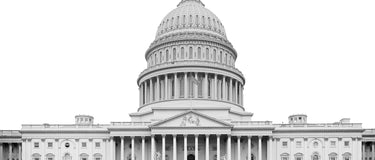George Washington laid the cornerstone of the US Capitol on September 18th, 1793, at the southwest corner of its foundation. This marked the building the most symbolically important building in the nation, as well as the most architecturally impressive. President Washington crossed the Potomac River with a company of volunteer artillery from Alexandria, and joined with Masonic Lodge members. The group marched to the Capitol site, which was about a mile and a half away, with music playing, colors flying, and drums beating. Spectators watched and cheered as the group passed. After the ceremony of laying the cornerstone, a celebratory barbecue took place, as well as other festivities, which took place until dark. The ceremonies and festivities signified the importance of this building, and what it represented to the American people; that citizens can build a government that is based on the consent of the governed, rather than being controlled by a dictator, king, or tyrant.
Before the cornerstone could be laid and festivities enjoyed, first a design and plan was needed for the construction of the Capitol Building. In the spring of 1972, Thomas Jefferson, the Secretary of State at the time, proposed a design competition. Over 10 individuals sent in design proposals, but unfortunately the level of architectural skill in the United States at the time was lacking, and the designs were considered to be amateurish and crude. A trained French architect named Stephen Hallet submitted the most promising design, yet his plans were considered too costly, and overly fancy, reflecting too much French influence.
A late entry came in from William Thornton in January of 1973. Thornton had studied medicine, but rarely practiced as a doctor, and was considered gifted as an amateur architect. His design received praise from Washington and Jefferson for its “Grandeur, Simplicity, and Beauty”. In an effort to keep Hallet involved, he was appointed by the commissioners to review Thornton’s plans, as well as develop cost estimates and serve as the superintendent of construction. Hallet considered Thornton’s plans to be costly and problematic, and began to pick them apart and make significant changes to the design plans. In order to address issues and revise Thornton’s original plans, Jefferson convened a five-member commission in July 1973, including both Thornton and Hallet, along with James Hoban, a fellow architect.

The earliest surviving photograph of the Capitol Building, 1846
Love this image? Click here to order it as a fine art print!
Construction proceeded slowly under the series of architects involved. The Senate wing was completed in 1800. Several years later in 1803 Benjamin Henry Latrobe was hired, and by 1811 he had renovated the Senate wing, as well as completely the House wing. During the War of 1812, British troops set fire to the Capitol, White House, and several other buildings in the District in 1814. A rainstorm fortunately prevented the complete destruction of the Capitol, and reconstruction and redesign commenced the following year.
The Capitol Building was considered to be complete in 1826, but by 1850 the enormous territorial growth of the nation caused a clear need for the enlargement of the Capitol. An appropriation bill was introduced in 1850 to enlarge the building. Architect Thomas U. Walter was selected by President Fillmore to construct large northern and southern wings, which would contain new legislative chambers. A new cast-iron dome was also designed by Walter to better suit the larger building. Work was finished in 1868.
For over a century, the Capitol Building was the only building created for the use of the country’s legislature. Initially, the Capitol did not only house Congress, but also the Supreme Court, the Library of Congress, as well as the district courts and their offices. Prior to establishing the nation’s capitol in Washington, DC, the Congress and its predecessors met in a number of locations, including Philadelphia and New York City.
-----
Looking for something else to read? Check out the history of the Library of Congress!
